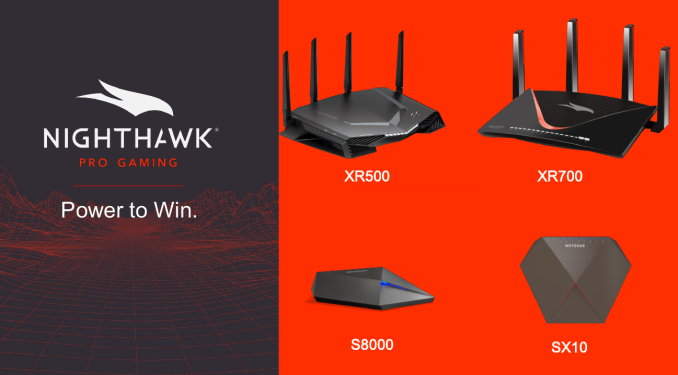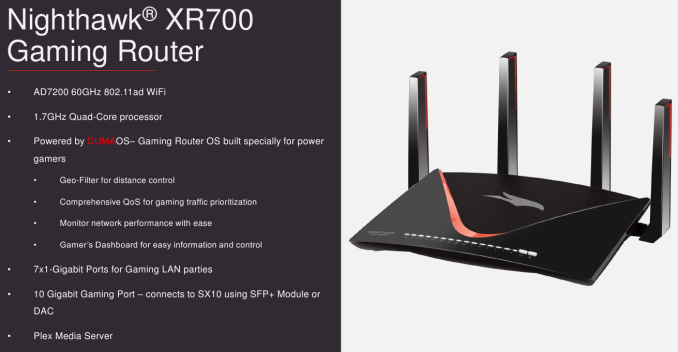Netgear XR700 Router Brings 802.11ad and 10G to the Nighthawk Pro Gaming Family
by Ganesh T S on August 30, 2018 5:30 PM EST
At the 2018 CES, Netgear had introduced the Nighthawk XR500 gaming router and the SX10 (GS810EMX) NBASE-T switch as part of the Nighthawk Pro family to server the needs of gamers. Today, they are launching the XR700 router that brings the capabilities of the router component to be a more powerful complement to the SX10 NBASE-T switch introduced earlier.
Similar to the XR500, the new XR700 router runs the DumaOS firmware developed by Netduma. DumaOS has been receiving frequent updates to enable compatibility of features such as geo-filtering with the latest games. The capabilities of DumaOS have been well-marketed by Netgear earlier. The main difference between the XR500 and the XR700 lies in the internal hardware.
While the XR500 was an AC2600 router with the Qualcomm-based Nighthaws X4S platform, the XR700 makes the step up to AD7200. This platform was last seen in the Nighthawk X10 launched in Q4 2016. It integrates an Annapurna Labs AL-314 SoC along with 802.11ac / 802.11ad radios from Qualcomm. In addition to the 802.11ad capabilities, the router also comes with a 10G SFP+ port. A direct-attach cable / SFP+ module (Netgear AXM765) to convert to 10GBASE-T is available separately. On the firmware side, we get the pre-installed Plex Media Server (similar to the Nighthawk X10).
The main differences between the Nighthawk X10 and the XR700 are:
- A different industrial design for the chassis, to better reflect the Nighthawk Pro gaming branding
- Replacement of the traditional firmware with the gaming-optimized DumaOS
- Abilitiy to use the 10G SFP+ port as a WAN port (the Nighthawk X10 restricted it LAN duties when it was launched).
- Value addition in the form of a 6 month unlimited Amazon Cloud backup
With the launch of the XR700, Netgear now has a powerful flagship in their Nighthawk Pro Gaming lineup. Combined with the S8000 and SX10 switches, Netgear is able to offer a complete solution for LAN gaming parties, while fulfilling the other requirements of the gaming crowd.
The Netgear XR700 has a MSRP of USD 500, and will be available for purchase in September 2018 for USD 500. The launch price of the Nighthawk X10 was also the same, but that product is available for $420 currently - a better price for those who need 802.11ad and 10G SFP+ without all the gaming features.
Source: Netgear











25 Comments
View All Comments
Makaveli - Thursday, August 30, 2018 - link
Looks nice but I wouldn't be buying any new routers now until we were 802.1AX and WPA3 in products. The Duma OS is fantastic though so +1 for that.Byte - Thursday, August 30, 2018 - link
Pretty useless as I don't think even the iphone Xs will have anything higher than AC. I don't see a need for 11ad in routers, range is show short anyways, best use case is mostly just VR.qap - Friday, August 31, 2018 - link
I don't know how you buy wifi aps, but when I buy one, it stays with me for at least a decade (until it stops working). Much longer than any phone. So if there is a major improvement around a corner, it's worth waiting for it. And WPA3 alone is good enough reason. OFDMA(throughput upgrade) and TWT(battery life for mobile devices), that are included in 802.11ax are other good reasons.Valantar - Friday, August 31, 2018 - link
Completely agree. I still haven't had compelling reason to replace my old (I think it's actually more than 10 years now) Dlink 11N router, which serves the phones and laptops in the household fine for now (everything else is wired). Then again, there's no way I'm paying $500 for a router either. I'll be moving some parts of the network to 10GbE as soon as =/< 3-port switches arrive at reasonable prices (for two PCs and a NAS), but from my POV combining this with a wireless router seems like a bad idea. One would think "all-in-one" solutions like this would be cheaper overall, but they aren't at all. Then there's the lack of a useful number of ports, and seriously, who needs 10GbE WAN? Then there's the fact that optimal WiFi router placement and wired switch placement are not the same thing at all. I get that I'm more willing to pepper my house with networking devices than the average user, but this isn't targeted at the average user either.Oh, and these mmwave networking standards seem rather silly, really. When line-of-sight is required for it to work, it can't be integrated into a huge device that also serves as a wired switch. Are we supposed to hang our routers proudly on the wall as if they were art? No thanks.
imaheadcase - Friday, August 31, 2018 - link
I mean 10GbE SEEMS overkill sure, but you got to remember how fast internet is changing. Technology changes so fast, remember when people debated if needed more than 4gigs of ram in a a system..most don't even consider it when building a new PC and go to 32gigs. Lots of stuff like that.But on to the real reason, check out internet speed increases and how fast they change. In 2001 i was paying $250 a month for 128k/128k ISDN line to house with a $500 install fee. That was way more than i needed then. Literally 3 years latter we moved into "town" and could get cable internet for 512K download with 56k modem for upload speed (called it telco return) for $100 a month!
Fast forward now and rocking 300/40 from Charter for $80 a month. lol
So you say 10GbE might now mean much now, but when the tech comes to be in some VR world with realistic graphics that requires constant bandwidth you will be like "whoah".
Valantar - Sunday, September 2, 2018 - link
Internet speeds aren't increasing that quickly, and we're seeing diminishing returns in terms of infrastructure upgrades vs. end-user speed increases. Gigabit Internet is still limited to a handful of cities globally, and that's not likely to change much in the next five to ten years. The vast majority of broadband connections even in Western countries are still <50Mbps. Sure, this router isn't targeting mass-market adoption, but a 10Gb WAN port is still silly even for enthusiasts. Can you find me a 10Gb modem that's not enterprise-grade?Also, "most don't even consider it when building a new PC and go to 32gigs. Lots of stuff like that." Sorry, what? Given RAM prices for the past couple of years, that's just absurd. Outside of people with too much money to care or people needing lots of RAM for video, CAD or similar work, it's been quite a while since I saw a proposed PC build beyond 16GB. And 16GB is still plenty for most use cases, after all. 8GB was plenty ten years ago; 16GB is plenty today - this isn't changing rapidly either.
nagi603 - Tuesday, September 4, 2018 - link
Do remember that in the UK and US, ISPs don't like to actually improve the network beyond basic necessities. So no, you won't be having 10Gbit 10 years from now. You'll be lucky to get 1Gbit, if you move to some special places.bcronce - Friday, August 31, 2018 - link
In order to properly shape your traffic, you should have 4x the bandwidth. This gives the line some breathing room and letting the edge router shape the traffic to your target rate. This is how I keep my bufferbloat around 1ms.pyrrh0 - Thursday, August 30, 2018 - link
What games require 802.11ad throughput? What client devices even support this? Ridiculously expensive for theoretical uses.SirMaster - Thursday, August 30, 2018 - link
Games? This kind of throughput is for transferring large files and stuff like that.